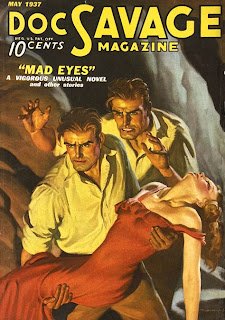 |
| Doc Savage cover (January 1939) by Emery Clarke Via www.pulpartists.com |
Clarke and Harris are remembered best for their front cover art on Doc Savage Magazine, while Luros is known for his detective and men’s adventure magazine covers, although he also did plenty of SF work.
PulpFest 2011 is a new and improved version of the venerable convention catering to fans and collectors of vintage popular fiction.
Born in 1911, John Emery Clarke studied on scholarship at the Kansas City Art Institute in Kansas City, Missouri in the 1930w. One of his more influential art teachers was the magazine illustrator, Monty Crews.
He moved to New York City in 1936 to find work as a magazine illustrator during the Great Depression. He was a next-door neighbour of Rudolph Belarski, for whom he occasionally posed.
He painted freelance covers for pulp magazines such as Action Stories, Fight Stories, Love Romances, Short Stories, Rangeland Romances, Star Western, Ten Detective Aces, 10-Story Detective, and Top-Notch, and several covers for Doc Savage.
 |
| Doc Savage cover (May 1937) by R. G. Harris Via www.pulpartists.com |
He shared art studio space in New York with John Falter, Emery Clarke, and Richard Lyon in the 1930s, with Charles LaSalle, John Scott, and Graves Gladney as neighbours. He studied with Harvey Dunn at the Grand Central School of Art and with George Bridgman at the Art Students League.
His first published assignments were story illustrations for Street & Smith's Western Story. He went on to paint covers for Complete Stories, Double Action Western, Doc Savage, Pete Rice Western, Thrilling Adventures, Western Round-Up, Western Story, and Wild West Weekly.
In 1937 he was signed by American Artists Agency, which helped him to move up from the pulps to illustrating slick magazines. He worked for Cosmopolitan,Good Housekeeping, Ladies Home Journal, Liberty, McCall's, Redbook, and The Saturday Evening Post.
During World War 2 he volunteered to join the USO Artists For Freedom Project, which was organized by the NY Society of Illustrators to bring together over 200 artists to draw thousands of portrait sketches of wounded servicemen recuperating in military hospitals.
 |
| Future Science Fiction cover (January 1952) cover by Milton Luros Via www.pulpartists.com |
After the second world war he continued to do freelance illustration for Crack Detective, Famous Detective, Smashing Detective, Astonishing, Dynamic Science Fiction, Future, and Science Fiction Quarterly and became the art director of a new pulp magazine produced by Columbia Publications, Famous Detective in 1950.
Pulp expert David Saunders notes that this same magazine also featured his cover paintings as well as his line art to illustrate interior stories. "No one else in the history of pulp art had ever simultaneously played all three roles of art director, cover artist, and interior line artist," he records.
Luros also wrote and drew a nationally syndicated newspaper comic strip called, Roger Lincoln, S-Man. The strip ran for four years, and folded in 1952 before starting the American Art Agency in 1955, helping many of his neighbourhood artists find work in other outlets in exchange for ten percent.
In 1957 he began to work for Universal Studios, where he designed movie posters and billboard advertising, and was publishing his own men's magazine, Cocktail by 1959 hich was distributed exclusively through liquor stores. He was soon the head of a publishing empire, Parliament News Distributors, Inc., which specialized in nudist and erotic publications, work that overshadowed his more general contributions to American culture and eventually and unjustly earned him the label of "the world's richest pornographer."
• Pulpfest 2011 takes place on Friday 29th July – Sunday 31st July at the Ramada Plaza Hotel and Conference Center in Columbus, Ohio. For further details on this fine presentation by pulp art expert David Saunders, visit www.pulpfest.com and, perhaps, sign up for their regular subscription service
• For more about American pulp magazines, check out David Saunders brilliant www.pulpartists.com - source of the artist information in this post.
No comments:
Post a Comment